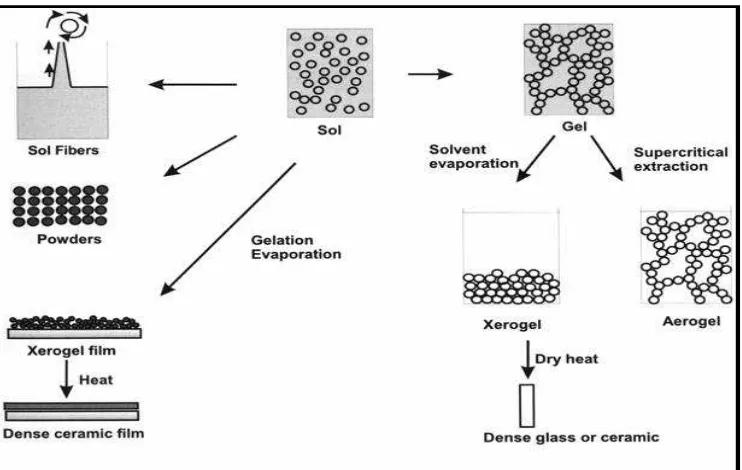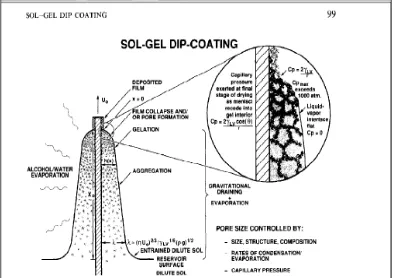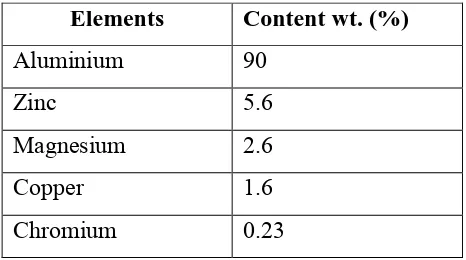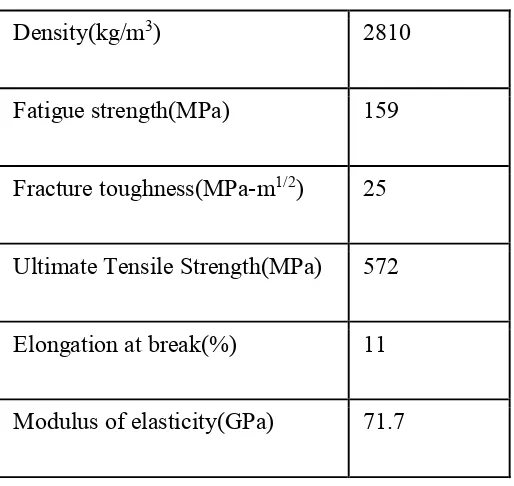UNIVERSITI TEKNIKAL MALAYSIA MELAKA (UTeM)
STUDY OF CORROSION RESISTANCE AND WEAR
BEHAVIOUROF SOL GEL COATING ON AA7075
Report is submitted in accordance with requirement of the Universiti Teknikal Malaysia Melaka (UTeM) for the Bachelor Degree of Manufacturing Engineering (Engineering
Materials) (Hons.)
by
MUHAMMAD HARITH BIN EZUDDIN B051110139
920827-08-5551
UNIVERSITI TEKNIKAL MALAYSIA MELAKA
BORANG PENGESAHAN STATUS LAPORAN PROJEK SARJANA MUDA
TAJUK: Study of Corrosion Resistance and Wear Behavior of Sol Gel Coating On AA7075.
SESI PENGAJIAN: 2014/15 Semester 2
Saya MUHAMMAD HARITH BIN EZUDDIN
mengaku membenarkan Laporan PSM ini disimpan di Perpustakaan Universiti Teknikal Malaysia Melaka (UTeM) dengan syarat-syarat kegunaan seperti berikut:
1. Laporan PSM adalah hak milik Universiti Teknikal Malaysia Melaka dan penulis. 2. Perpustakaan Universiti Teknikal Malaysia Melaka dibenarkan membuat salinan
untuk tujuan pengajian sahaja dengan izin penulis.
3. Perpustakaan dibenarkan membuat salinan laporan PSM ini sebagai bahan pertukaran antara institusi pengajian tinggi. atau kepentingan Malaysia sebagaimana yang termaktub dalam AKTA RAHSIA RASMI 1972)
(Mengandungi maklumat TERHAD yang telah ditentukan oleh organisasi/badan di mana penyelidikan dijalankan)
Alamat Tetap:
DECLARATION
I hereby declare this report entitled STUDY OF CORROSION RESISTANCE AND WEAR BEHAVIOUR OF SOL GEL COATING ON AA7075 is the result of my own
research except as cited in the references.
Signature :
i
ABSTRAK
ii
ABSTRACT
iii
ACKNOWLEDGEMENT
v
CHAPTER 4: RESULTS AND DISCUSSION 25
vi
Chapter 5 :CONCLUSIONS & RECOMMENDATIONS 34-35
REFERENCES 36-38
APPENDICES 39
A GANTT CHART PSM I 40
vii
LIST OF TABLES
2.1 Composition of alloying elements in AA7075 11
2.2 Properties of AA7075 12
3.1 Sol components ratio 19 3.2 Amount of each sol component and final TEOS concentration 19 4.1 The composition of silicon present in the AA7075 substrate 26 4.2 The water to TEOS ratio at different concentrations 27 4.3 The thickness of coating according to TEOS concentrations 30 4.4 Polarization parameters for bare Al substrate and Al substrate coated with
various concentrations of MPTS sol gel in 3.5% NaCl 32
viii
LIST OF FIGURES
2.1 Sol-gel synthesis to produce various materials 5 2.2 Basic sol-gel reaction 5
2.3 Dip-coating mechanism 9
3.1 The experimental procedure flowchart 17
3.2 Dip-coater machine 20
3.3 Scanning Electron Microscopy 21 3.4 X’pert Pro Diffractometer 22 3.5 Ball-on-disc Wear Test 23 3.6 Three Electrode System Glass Cell 24 4.1 The silica composition at different concentrations 26 4.2 SEM images of sol gel coating 28 4.3 SEM images of coating cross-section 29 4.4 Polarization curves for bare Al substrate and Al substrate coated with various
concentrations of MPTS sol gel in 3.5% NaCl 31
ix
LIST ABBREVIATIONS, SYMBOLS, NOMENCLATURE
Al = Aluminium C = Carbom
Cl = Chlorine H = Hydrogen ml = Mililiter Si = Silica
HCl = Hydrochloric acid TEOS = Tetraethyl orthosilicate
MAPTS = Methacryloxypropyl trimethoxysilan Zr = Zirconia
1
CHAPTER 1
INTRODUCTION
1.1 Background of Study
2
a system of colloidal particles in the solution (sol) become a macroscopic material (gel), which is merged by a liquid. As the liquid evaporates, a strong glass-like material remains. This is part where interest for sol-gel process lies because the deposited ceramic coating is chemically inert compared to CCC.
Even though prior researches and studies have proven excellence corrosion resistance of sol-gel coating on various metal alloy, but very little was found in the literature on the question of wear behaviour of this coating towards the substrate. This research aims to know the performance of sol-gel coating particularly on AA7075 in terms of wear behaviour, adhesion as well as corrosion resistance and how the variation of certain parameter and heat treatment process would affect those performance.
1.4 Problem Statement
3
1.2 Objectives
1. To characterize the hybrid TEOS-MAPTS sol-gel coatings on the AA7075 substrate produced at various TEOS concentration
2. To determine the corrosion resistance of sol-gel coating on the AA7075 substrate at various TEOS concentration.
3. To identify the wear behaviour of sol-gel coating on the AA7075 substrate at at various TEOS concentration in 3.0 % NaCl solution.
1.3 Scope of Study
4
CHAPTER 2
LITERATURE REVIEW
2.1 Introduction
This chapter reviews the previous researches and studies on the sol gel coating and related topics. Thorough the literature review, the principle of sol gel process its performance as protective coating have been studied and discussed.
2.2 Sol-gel
2.2.1 Mechanisms
5
Figure 2.1: Sol-gel synthesis to produce various materials.
(Source:https://str.llnl.gov/str/May05/Satcher.html)
Brinker and Scherrer (1990) defined sol gel process as creation an oxide network by progressive condensation reactions of molecular precursors in a liquid medium. Precursor is a compound that involved in chemical reaction to yield another compound. TEOS , a colourless liquid with chemical formula Si(OC2H5)4, is
commonly used as precursor in sol gel route due to its property which is easy to convert to silicon dioxide.
Generally, the sol gel reaction starts with hydrolysis of precursors then followed by condensation reaction to produce a macroscopic gel as illustrated in Figure 2.2.
hydrolysis Condensation Figure 2.2: Basic sol-gel reaction
Gel Sol
6
There are two ways to prepare sol gel coating- the inorganic method and organic method. The inorganic method involves the two evolution of networks through the formation of colloidal suspension and gelation of the sol whereas for organic method, it generally starts with a solution of metalloid alkoxide precursors M(OR)n in an
alcohol or other low-molecular weight solvent. M here denote a network-forming element, such as Zr, Ti, Al, Si, etc.; and R is typically an alkyl group (Cx H2x+1). (Wang
and Bierwagen, 2009).
2.2.2 Sol-gel as Protective Coating
Metal oxide coatings such TiO2, ZrO2 and SiO2 have a very good chemical stability
and can provide good protection to metal substrate. .SiO2 improves the oxidation and
acidic corrosion resistance of metals under different temperatures due to its high heat resistant and chemical resistance (Galliano, 1998).
Silica coating has been used on surfaces of steel, carbon and aluminium to promote adhesion, minimise photodegradation, or prevent material oxidation and corrosion (Schwarz, 1999).The silica coating by the sol-gel process is conducted in an organic solvent. The precursor of TEOS hydrolyse in the presence of water and catalyst, followed by condensation with surface metal hydroxyls. The Si-O-M chemical linkage is established between surface metal atoms (M) and TEOS, followed by lateral polymerization and finally the formation of a 3-D network via the formation of siloxane bonds with increasing TEOS concentration and hydrolysis.
7
not introduce impurities into the end product as initial substances. Meanwhile, Alain (1998) stated that the association of the solid colloidal state with a liquid medium avoid any pollution by the eventual dispersion of dust.
In sol-gel process, inorganic solids can be produced and processed at temperatures which are considerably lower than those in conventional methods (Wright and Sommerdijk, 2001).
Sol-gel coating can be applied to produce multilayer coatings. Further, this method also allow the preparation of composite which cannot be obtained by other methods, such as organic-inorganic hybrid materials (Wright and Sommerdijk, 2001).
However, in spite of the advantages of sol-gel oxide coating offers, previous researches have pointed few weaknesses of inorganic oxide coating. Wang and Bierwagen(2009) stated that the inorganic oxide films are brittle and it is difficult to achieve thicker coatings without cracking. They found that relatively high temperature is always needed to achieve good properties of inorganic oxide coating.
Rahimi et al., (2013) suggested that the formation of inorganic-sol gel derived films may not provide adequate barrier properties to prevent the corrosion, due to pores and crack present after the drying procedure.. While Conde et al.,(2003) reported sol-gel materials based solely on inorganic systems usually quite porous, unless densification is carried out at high temperature, which can disturb the properties of base metal.
2.2.3 Hybrid sol gel coating
8
coatings The inorganic coating is achieved by combining different precursors. Chou et al., (2001) in their experiment by using TEOS and MPTS on 304 stainless steel found that the hybrid coating deposited is relatively dense, crack free and uniform. Rahimi et al.,(2013) in their research of coating AA5053 through sol-gel technique showed that crack-free films with smooth surface is obtained by mixing TEOS and GPTMS as precursors.
The microstructure of the silica coating obtained through sol-gel process depends on the hydrolysis and condensation reactions which are controlled by few factors. One of the factors is concentration of TEOS. According to Barbé et al,(2005), an increase in the TEOS concentration contributes to an increase in the solution’s viscosity and thus increase the rate of hydrolysis and condensation reaction.
2.2.4 Dip coating
According to Brinker et al.,(1991) dip coating is a process of withdrawing the substrate from the a fluid sol(gravitational draining and solvent evaporation) and followed by further condensation reactions, which shrink the film into a gel. Once it has collapsed fully, a dense sol-gel thin film remains. During the deposition stage there is a constant competition between condensation reactions and evaporation. The condensation reactions act to stiffen the structure while the evaporation compacts it. The entire process, including the aggregation, gelation and drying occurs within seconds for the dipped slides (Mellor, 2001).Figure 2.3 illustrates the dipping process.The substrate is usually withdrawn vertically at a speed U0. As the solvent is evaporating and
9
Figure 2.3: Dip-coating mechanism Source : Brinker et. al, (1991)
2.2.5 Applications
10
2.3 Aluminium
Aluminium is a silvery-white-look, soft, and ductile metal from Group 13.It is the third most abundant element after oxygen and silicon. Its low density property and ability to resist corrosion due to the passivation reaction make it a significant choice as structural materials for transportation. When aluminium surface is exposed to the atmosphere, the natural oxide film is formed which are responsible for its corrosion resistance. However, this natural oxide film cannot protect the metal in severe corrosive environments (Vignesh et al., 2013).
2.3.1 Aluminium alloy
11
in considerable amounts at elevated temperature, but t a much smaller degree at room temperature (John, 1984).
2.3.2 Aluminium alloy 7075
Aluminium alloy 7075 is an aluminium alloy with zinc as its primary alloying elements. The presence of zinc as major alloying element will increase the strength and allow hot or cold precipitation hardening. The composition of elements present in AA7075 is shown in Table 2.1. AA7075 is widely used in transport applications especially in aeronautical industries due to their attractive comprehensive properties such as low density, high strength and resistance to fatigue. Table 2.2 shows the mechanical properties of AA7075.
Table 2.1:Composition of alloying elements in AA7075
Elements Content wt. (%)
12
Table 2.2: Mechanical properties of AA7075
Density(kg/m3) 2810
Fatigue strength(MPa) 159
Fracture toughness(MPa-m1/2) 25
Ultimate Tensile Strength(MPa) 572
Elongation at break(%) 11
Modulus of elasticity(GPa) 71.7
2.4 Wear
2.4.1 Definition



